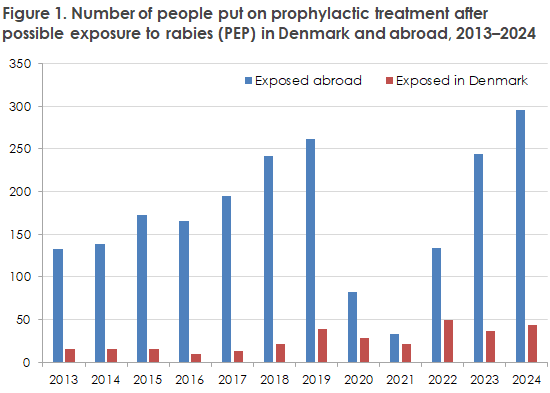No 40 - 2025
Compilation of rabies prophylaxis and rabies examinations in Denmark in 2024
Compilation of rabies prophylaxis and rabies examinations in Denmark in 2024
For a detailed description of rabies Post-Exposure Prophylaxis (PEP) and the examination of animals for rabies in Denmark in 2024, please refer to the annual report.
Continued increase in the number of people receiving rabies prophylaxis following exposure abroad
In 2024, a total of 340 individuals received PEP following possible exposure to rabies after animal bites. The majority of these (n = 296; 87%) were exposed abroad, most frequently during travel to Thailand and Turkey.
The number of PEP treatments administered after possible exposure to rabies infection abroad has continued to increase, and in 2024 it exceeded pre-pandemic levels observed before the reduction in travel activity caused by COVID-19. The data further indicate that access to rabies immunoglobulin abroad remains limited. Among the 296 individuals exposed to possible rabies infection abroad, only 44% received HRIG, of which 40% (52/130) were treated only when they returned to Denmark.
In the first half of 2025, a clear continuation of the rising trend can be seen, and with even further intensity. This underscores the importance of strengthening rabies prevention efforts in connection with pre-travel vaccination counseling for people traveling to countries where the disease is endemic.
It is both costly and unnecessary that travelers are evacuated home from vacations because rabies immunoglobulin and/or rabies vaccines are not widely available in the countries they have travelled to. If a person has received two rabies vaccines (pre-exposure vaccination, PrEP) prior to their departure to areas where rabies occurs endemically, there is no longer an indication for rabies immunoglobulin, and one can instead suffice with two further vaccinations as PEP.
Although the indication for pre-exposure vaccination should always be assessed on an individual basis, it is strongly recommended to consider this option—even for shorter trips—and particularly for travel to destinations where rabies immunoglobulin is known to be difficult to obtain. It is equally important to advise travelers to avoid contact with animals in areas where rabies remains endemic.
Rabies exposure in Denmark
In 2024, a total of 44 individuals received PEP following possible exposure to rabies in Denmark. This number is above the five-year average of 35 individuals. Bites or scratches from bats were the reason for initiating PEP in 40 of the 44 exposed persons.

Rabies in animals
Denmark has been free of classical rabies since 1982, while European bat rabies sporadically occurs in Danish bats.
In 2024, three cats, one dog, and one fox were examined on suspicion of rabies, all with negative results. In addition, 31 bats were submitted for examination via Danish surveillance programs and tested for rabies with negative results.
Classical rabies occurs endemically in Greenland, where polar foxes regularly spread the infection to other mammals. In 2024, a total of five polar foxes from Greenland were examined, all of which tested positive for classical rabies virus.
(S. Voss, M. Wessman, Infectious Disease Epidemiology and Prevention, T.B. Rasmussen, Virology and Microbiological Preparedness)